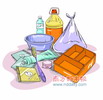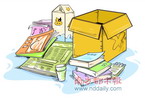| According to their composition, recycling value and impact on the environment, urban solid wastes in Guangzhou are classified into four categories: recyclable waste, kitchen waste, harmful waste, and other wastes. |
|
Pursuant to Article XI of Interim Provision on Systematic Management of Municipal Solid Waste in Guangzhou, the municipal solid waste in our city can be classified into four categories, namely, recyclable waste, kitchen waste, harmful waste, and other wastes. The citizens can further subdivide it based on the four categories.
※ Recyclable waste
Recyclable waste includes uncontaminated household waste suitable for recycling and resource utilization.
 -Waste plastics
-Waste plastics
For example, plastic bags, plastic cutlery (lunch boxes, bowls, spoons), plastic fresh food boxes, fresh bags (preservative films), plastic films, plastic bottles, plastic oil cans, plastic pots, barrels and other containers, plastic house wares, plastic stool chairs, plastic stationery, plastic toys, plexiglass products, CDs and tapes, over plastic film, protective film, toothbrushes, toothpaste tubes, foam plastics and so on.
 -Waste paper categories
-Waste paper categories
For instance, newspapers, magazines, books, leaflets, envelopes, packaging boxes of food and goods, shopping bags, egg boxes, paper packaging of drinks and milk, instant noodle boxes, disposable cups, disposable paper tableware, computer printing paper, copy paper, fax paper, notes, calendars, notebooks, cartons and so on.
 -Scrap metal
-Scrap metal
Such household appliances and supplies which are made of metal as pop cans, tins, clothes hangers, toys, cutlery, utensils, stationery, furniture and so on.
 -Waste glass
-Waste glass
Such colored and colorless glass products as glass bottles, glasses, glass table tops, glass tea tables, glass ports, etc.
※ Collection containers for recyclable waste: 
※ Classifying label - 
※ Classification methods
• The residents shall, according to the classification standards, put waste in separate bags and dump waste into the classified containers in the corridors or garbage rooms according to the regulations on regional household waste discharge, and leave the waste to be collected by sanitation workers.
• In residential areas restricted by environmental conditions, the residents can divide the waste into kitchen waste and other waste and discharge them. Then the sanitation workers will carry out a secondary classification pursuant to the four classification standards.
• An appointment can be made for recyclable waste to be recycled by means of door-to-door paid recovery by service businesses, or they can be sent by oneself to the nearest recycling business sites or put into collection containers for recyclables.
• Before discharge of waste paper, the plastic covers, outer envelopes, staples, etc. should be removed, spread out, folded and bundled; bottles and other containers should be emptied of contents; the tubes of Tetra Pak should be drawn out and the Pak be flattened; hybrid items such as paper, plastic, metal, etc. should be disassembled in terms of attributes.
• Sorting and storage of recyclable waste is forbidden in sidewalks, green spaces, leisure areas and other public areas.
* Kindly Reminders:
(1) The discharge of large waste such as discarded furniture and household appliances, waste big-ticket appliances and electronic products can be carried out by ordering a door-to-door paid recovery provided by sanitation service enterprises and paying labor costs.
(2) Broken glass and other sharp objects should be wrapped in paper before dumping so as not to hurt others.
 ※ Kitchen waste
※ Kitchen waste
Kitchen waste refers to organic perishable waste generated by families, including food residue discarded and left in food trade and production.
Examples are items such as rice, pasta, expired food, meat, fish and shrimp (may contain shell) classes, crab shells, shells, bones, vegetables, fruits, husk core, cane trash, tea residues, durian shells, coconut shells, and abandoned branches (leaves) from family potted plants and so on.
※ Collection containers for kitchen waste: ![]()
※ Classifying label - 
※ Classification methods
• Kitchen waste should be put in exclusive garbage bags, sealed and dumped into collection containers for kitchen waste.
 ※ Harmful waste
※ Harmful waste
Harmful waste refers to substances which can cause direct or potential harm to human health or natural environment. For example, waste medications and their packaging, waste pesticides and disinfectants and their packaging, waste paints and solvents and their packaging, waste mineral oil (waste cosmetics) and its packaging, waste film and waste photographic paper, waste fluorescent light tubes, waste thermometers, waste blood pressure monitors, waste cadmium-nickel batteries like rechargeable batteries, button batteries, etc., waste mercuric oxide cell and harmful electronic waste, and so on generated in everyday life .
※ Collection containers for harmful waste: 
※ Classifying label - 
※ Classification methods
• Harmful waste should be put into garbage containers for harmful waste in designated sites in residential areas or exclusive recycling bins installed by shops or enterprises.
※ Other wastes
Other wastes refer to the other household rubbish except recyclable waste, kitchen waste and harmful waste.
 For example, discarded sanitary napkins, paper diapers, napkins, toilet paper, tissue paper, wet tissue paper, cigarette butts, ceramic products, glass fiber products (such as safety helmets), sponge, travel bags, balls, flower pots, rugs, mats, bath towels, towels, hats, quilts, pillows, bed sheets, bed spreads, fabrics (including rags), clothing, footwear, socks, curtains, tablecloths, aprons and so on.
For example, discarded sanitary napkins, paper diapers, napkins, toilet paper, tissue paper, wet tissue paper, cigarette butts, ceramic products, glass fiber products (such as safety helmets), sponge, travel bags, balls, flower pots, rugs, mats, bath towels, towels, hats, quilts, pillows, bed sheets, bed spreads, fabrics (including rags), clothing, footwear, socks, curtains, tablecloths, aprons and so on.
※ Collection containers for other wastes: 
※ Classifying label - 
※ Classification methods
• Other wastes should be put in garbage bags and dumped into collection containers for other wastes.
• Items such as abandoned flowers and plants as good luck flowers and others should be discharged at a fixed time and area and be fully utilized in accordance with the requirements of the regional urban management department.
* Kindly Reminder:
The city management departments will, in accordance with the development of waste disposal technologies and the feasibilities of treatment, make timely adjustments on the classified categories of the above-mentioned living waste.
In conclusion, with household waste discharge, the waste should be accurately put into collection containers to prevent its impact on the environment and the occurrence of environmental pollution. In this way everyone in the community benefits.

